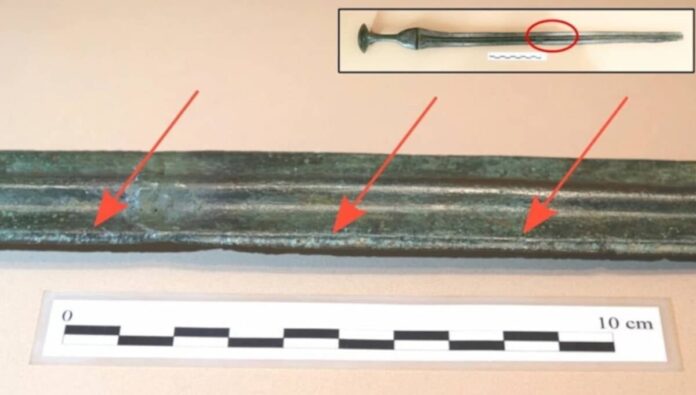A recent study uncovered new details about the manufacture, material composition, and cultural significance of Late Bronze Age swords found during 20th century excavations on Spain’s Balearic Islands in the western Mediterranean. These swords, dating back approximately 3,000 years, were collected between the years 1000 and 800 BC.
The University of the Balearic Islands team, led by archaeologist Laura Perelló Mateo, conducted a scientific analysis of these artifacts, as reported in Archaeological and Anthropological Sciences journal. They investigated the manufacturing techniques and measured the chemical and isotopic compositions of the metals used in these swords.
The Balearic swords examined in the study displayed a blend of local manufacturing traditions with external influences. The researchers noted the use of imported manufacturing and design innovations such as lost-wax casting and the use of complex bronze alloys.
Sketch of details of swords found in the Balearic Islands. (L. Perelló Mateo et al./Archaeol Anthropol Sci)
Sword Making with a New and Unique Style
During the 14th and 13th centuries BC, increased trading and cultural exchange in the western Mediterranean benefited the Balearic Islands, situated 160 miles off the Iberian Peninsula’s coast. As Perelló Mateo and her team calculated, the metal objects recovered from Mallorca, Ibiza, and Formentera increased significantly from the Early to Middle and Late Bronze Ages, reflecting the impact of trade on the sword-making industry.
“The objects [swords] are made with foreign raw materials,” the study authors noted. “Since there are no deposits of tin in the Balearic archipelago, obtaining this metal is always related to foreign relations.”
The Balearic swords represented a shift in economic and cultural interactions in the western Mediterranean in the late second millennium BC. While influenced by foreign concepts, the islanders uniquely adapted the sword-making process, resulting in distinctive designs not seen elsewhere.

Image of the sword from Ses Salines and a close-up of the blade made to look like a sheath cast as one single piece. (L. Perelló Mateo et al./Archaeol Anthropol Sci)
A total of 18 Late Bronze Age swords, primarily from Mallorca and Menorca, were analyzed. These swords featured unique elements like solid grips and thinner blades attached with direct casting or rivets. The study revealed that these swords were likely symbolic objects rather than functional weapons.

Image of the machete from Lloseta (Archeology Museum of Catalonia). Drawing by Delibes and Fernández-Miranda 1988. (L. Perelló Mateo et al./Archaeol Anthropol Sci)
Excavating the Lost World of the Mysterious Talaiotic Culture
The recovered swords in the Balearic Islands are associated with the Talaiotic culture, known for their construction of talaiots. These people, of unknown origin, built these structures in various locations on the islands, possibly for ceremonial or community purposes. The swords found in Talaiotic villages and settlements were likely used in rituals or displayed at community events.
The swords reveal the integration of the Balearic Islands into the regional culture of the western Mediterranean by the early first millennium BC. These innovative designs reflect the islanders’ unique adaptation to foreign influences, shedding light on their interactions with the outside world.
Top image: Image of the sword from Lloseta and detail of the burrs on the edge of the blade. Source: Archaeology Museum of Catalonia/Archaeol Anthropol Sci
By Nathan Falde






